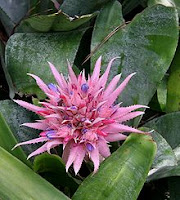By Nancy J. Farrier
Ganna Walska, born Hanna Puacz, in 1887, came from
Brest-Litovsk, Poland. Her interesting life included opera singing, and
marriage to six husbands, several of them very wealthy. Her legacy includes a renowned botanical garden in Southern California.
When Hanna began to study music, she adopted the stage name
of Madame Ganna Walska. Ganna, the Russian form of Hanna, Walska, similar to
her favorite music, the waltz, and Madame being the title used for actresses
and opera singers in Europe. Ganna had aspirations to rise to the top and be
known for her singing.
From accounts of her opera singing, I gather Ganna had a
worthy voice, but
nerves rendered her incapable of performing to the degree
needed. She tried many remedies to combat the nerves, but according to her
memoirs, Always Room at the Top, nothing worked. She sang at many venues in New
York and Paris, but she wrote that during a performance of Giordano’s, Fedora, in Havana, she veered off key so
much that the audience pelted her with rotten vegetables.
 |
| Bromeliad Flower |
After marrying her fourth husband, Harold Fowler McCormick,
in 1922, Ganna purchased the Théâtre des
Champs-Élysées in Paris. She invested her own
funds, not those of her wealthy
husband, and told a reporter, "I will never appear in my own theatre until
I have gained recognition based solely on my merits as an artist."
McCormick loved her voice and promoted her career in lavish ways. Many people
claimed McCormick to be the only person who truly loved Ganna’s singing.
 |
| Lotus Flower |
Despite the thousands of dollars, McCormick spent on her
voice lessons, Ganna still struggled with maintaining a presence on the stage.
In 1925, a New York Times headline reported, "Ganna Walska Fails as
Butterfly: Voice Deserts Her Again When She Essays Role of Puccini's
Heroine" (January 29, 1925) Ganna’s opera career inspired Orsen Welles to
include her in his movie, Citizen Kane. The character of Susan Alexander was reportedly based on Ganna Walska.
 |
| Lotusland Entrance |
Her creative talents led Madame Walska to group plant types
together, also trying to purchase the most unusual of each type of plant.
Lotusland today still reflects this original purpose with a variety of gardens
scattered throughout the whole.
 |
| Agave |
The Parterre is a more formal part of Lotusland. Here there are low hedges and brick walkways lined with plants. There are two central water features, one
being a Moorish fountain first put in by the estate’s original owners. There are pebble mosaics, commissioned by Madame Walska. The Parterre leads into the Topiary garden which has a central clock that is 25 feet in diameter. Each section of the clock contains succulents and a copper zodiac symbol. The clock was added in 1955.
 The last garden Ganna Walska created was the Cycad garden.
It is said she auctioned off some of her extensive jewelry collection to fund
the purchase of the cycads. Lotusland is thought to have the most complete
collection of cycads found in an American public garden. There are over 900
specimens, many endangered or extinct in the wild.
The last garden Ganna Walska created was the Cycad garden.
It is said she auctioned off some of her extensive jewelry collection to fund
the purchase of the cycads. Lotusland is thought to have the most complete
collection of cycads found in an American public garden. There are over 900
specimens, many endangered or extinct in the wild.
Madame Ganna Walska accomplished much in her lifetime. Have
you ever read about her? Have you ever visited Lotusland? I haven’t been there,
but after researching this blog, I know I will go as soon as I have the
opportunity.
Nancy J Farrier is an award winning author who lives in
Southern California in the Mojave Desert. She loves the Southwest with its
interesting historical past. Nancy and her husband have five children and one
grandson. When Nancy isn’t writing, she loves to read, do needlecraft, play
with her cats, and spend time with her family. Nancy is represented by Karen
Ball of The Steve Laube Literary Agency. You can read more about Nancy and her
books on her website: nancyjfarrier.com.





I have been to Santa Barbara many times but never to Lotusland. Now that I know the history. I must try to visit. Sm. wileygreen1(at)yahoo(dot)com
ReplyDeleteI do hope you get to visit, Sharon. I was so fascinated by the history behind Lotusland, that I'm excited to go there.
DeleteVery interesting, Nancy, especially since my husband and I used to own a commercial greenhouse. No, I've heard of Madame Ganna Walska or Lotusland, and I have a deep respect for anyone who values botany over jewelry. Kudos to her.
ReplyDeleteLotusland is going on my bucket lists as one of the great botanical gardens I'd like to see someday.
Thank you for sharing your research with us.
Thank you, Anita. I have a long list of botanical gardens I would love to see. Thanks for commenting.
DeleteGood morning, Nancy. Fascinating post. Thank you. No, reading about Madame Ganna Walska & Lotusland here is a first for me. I love cactus, succulents and euphorbias, especially what we call Christmas Cactus and Thanksgiving Cactus. I recently learned the different between them - the Thanksgiving Cactus has a jagged edge, but the Christmas Cactus is rounded without points along the edge. Adding to my collection of leaf color as often as possible.
ReplyDeleteLinda, thank you for your comments. I love cacti and succulents too. It's always fun to learn more about the things that interest us.
Delete